Utah Spiders: Guide to Identification & Prevention
By Thorn Team • Jul 29th 2021
Finding spiders in your home or business can be an uncomfortable discovery. While you may tolerate the eight-legged creatures, few people want to experience an abundance of spiders.
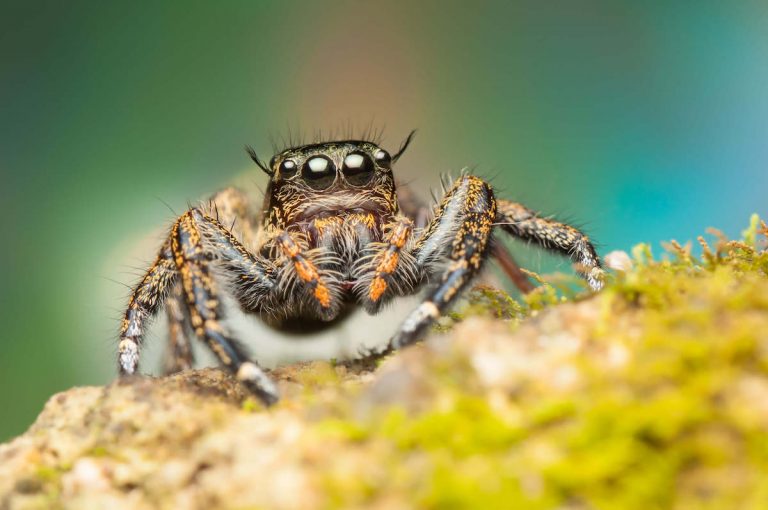
While having some spiders around is useful for keeping other insect populations down, it's okay to want some control over your environment. That's where we come in: Thorn can help you understand and manage your spider issue. We know about Utah spiders, their environments, and how to manage them in a humane and conscientious way.
In this guide, you'll find tips for identifying common species of spider native to Utah and we'll offer some cultural practices and other control methods to help prevent infestations so you can live and work with ease.
Utah Spider Bite Health & Safety
Spider Infestation Prevention Tips & Tricks
Common Spider Species in Utah
Utah has a variety of species: There are 621 different species of spiders here in Utah, according to Utah State University. One of the biggest spiders that's commonly found throughout the state is the wolf spider, which thankfully isn't harmful to humans. Most common species of Utah spiders and throughout North America aren't harmful to humans. Only the black widow and desert recluse spiders' bites require medical attention. The desert recluse is a troublesome spider, but luckily is typically only found in southern Utah. A few specimens have been found in Northern Utah.
Black widows are often considered one of the most dangerous venomous spiders in Utah, so read on to learn how to identify and prevent them from creeping around your home or business.
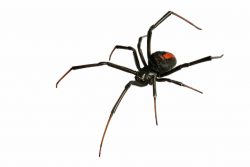
Black Widow
One common spider to Utah is the black widow spider . These spiders love dimly lit areas such as garages, shrubbery, wood piles, crawl spaces, the space beneath porches, or tight crevices.
Female black widows are easy to spot, with shiny black exoskeletons and a spherical abdomen. Most will have the signature orange or red hourglass on the undersides of their abdomens, but some may be missing the trademark sign, so it's best to be wary around all spiders that have a similar appearance. Male black widows are smaller (about one-third the size of females) and are light brown in color with similar markings to a juvenile female.
These spiders are one of the more dangerous species found in Utah. Their bite can cause pain, nausea, cramping, and death (very rare). If bitten, you should seek medical attention, and it's a good idea to capture the spider that bit you to correctly identify it as a black widow.
To keep black widows at bay, minimize clutter in your home and garage, which reduces that amount of area where the spiders can build their nests. Avoid placing shoes in your garage: Black widows have been known to build their nests inside abandoned footwear. Make sure you have tight fitting door sweeps and eliminate any cracks and crevices on the exterior of the home that could allow spider entry.
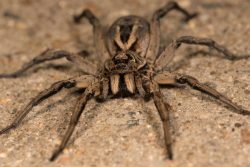
Wolf Spider
Wolf spiders often enter homes looking for prey. These spiders are diurnal meaning that they are awake in the daytime so they are seen by homeowners more often than some of the other spiders. They have a unique eye pattern with two eyes in the back, two larger eyes in front, with a line of 4 smaller eyes below the front eyes.
Wolf spiders are about one-half inch to two inches long and are hairy and wolf-like, brown or gray, and with different lines or markings on their abdomens. Rather than spinning a web to capture their prey, these spiders hunt and are usually on the move.
A wolf spider mother can sometimes be seen carrying a large egg sac around with her. Upon hatching, the baby spiders will hitch a ride on their mother's back until grown enough to roam on their own. While wolf spiders are not poisonous, their bites may cause irritation.
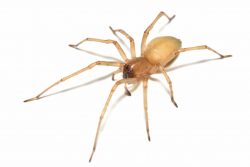
Yellow Sac Spider
The yellow sac spider is quite common to Utah, and these house spiders can often be spotted walking on walls and ceilings inside your home or business. While yellow sac spiders are not poisonous, they are known to bite multiple times if trapped inside clothes, and their bite can be quite painful.
You can usually identify a yellow sac spider by the signature small white silken retreat where the ceiling and walls meet. They spend the day in their saclike retreats and hunt at night. They have eight eyes in two rows, and are known to eat pest arthropods such as garden insects or other spiders.
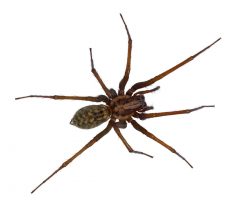
Hobo Spider
Another spider to watch out for in Utah is the hobo spider , most often discovered between June and September. Hobos are not great climbers and often hang out near the ground or in basements. They're brown with long legs and can move quickly.
Hobo spiders have signature webs: They build horizontal webs with a funnel at the end. Most research shows that hobo spiders are not dangerous but if you've been bitten by a hobo spider, attempt to capture the spider for identification purposes. Hobo spider bites are often mistaken for brown recluse bites, but brown recluse spiders are not commonly found in Utah. We have met several people here in Utah that have received a bite that was necrotic, flesh eating, but the spider was captured or identified so trying to capture the spider when bitten is important.
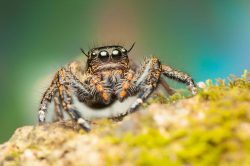
Jumping Spider
The jumping spider is one of the easiest Utah spiders to identify, however its appearance can vary quite widely. They are a smaller spider with an eye pattern that gives the appearance of two small eyes and large nostrils. The most common jumping spider in Utah, the bold jumper, has a black body, green chelicera (fangs), and a dot on the back of the abdomen.
Jumping spiders are not harmful to humans, but their jumping abilities could startle spider-wary folks. These spiders are active in the day and they stalk their prey. They have very agile and erratic movements.These spiders are often found in fields and grasslands, but are frequently found on fences, exterior walls, and in gardens.
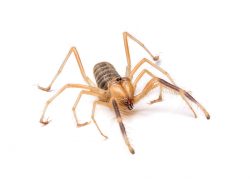
Camel Spider (Sunspider)
The camel spider is a harmless creature, and in fact, isn't actually a spider at all. Camel spiders are actually in their own order of arachnids known as Solifugae. They can appear to be quite menacing, but they're not harmful to humans however their bites can be quite painful.
They can grow quite large up to three inches long but are more commonly about one-and-a-half to two inches long. Camel spiders are fast and nocturnal, and love dry environments hence their prevalence in Utah. These arachnids are more common in the more desert regions of the state.
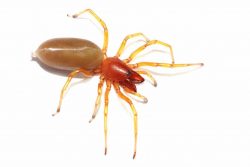
Woodlouse Spider
One of the more beneficial spiders to have in your home or business is the woodlouse spider, which feeds exclusively on isopods also known as woodlice, rolly pollies,or pill bugs. They have six eyes and a dark red head and legs with a shiny yellow-brown abdomen. They have large fangs that protrude directly in front of the head which are used to pierce the thick armor of isopods.
The woodlouse spider is more commonly found under logs in warmer environments, and occasionally can be found in homes. Woodlouse spiders can bite humans when they feel threatened, but their bite isn't very painful and their venom isn't harmful to humans. You may experience some itchiness where the spider bit you.
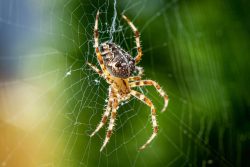
Orb-Weaving Spiders
Also known as the banded garden spider, orb-weaving spiders are often found in the fall months in Utah. These spiders make characteristic geometric webs that can be found most often near outside lights where they can capture flying insects.
Orb-weaving spiders are not dangerous to humans. They are excellent pest control spiders, and should be released back into the outdoors if found in your home or business.
Spider Infestations
As you've learned thus far, spiders tend to enjoy dark, private spaces, and many enjoy creating their nests in areas with wood think firewood piles or wood sheds. These are areas where other pests also tend to thrive, creating an abundance of food for your eight-legged crawlers.
Spiders will go where they feel safe and well-fed: Nests are often found in places where humans don't often go. One way to keep spiders away is to keep areas uncluttered and clean. It's likely that some parts of your home may not be frequently visited by your family. For this reason, it's wise to exercise caution and turn on lights to avoid an unexpected encounter.
If you have areas of your property where you've found an infestation, it's important to connect with Thorn spider control professionals who can identify the spiders and help manage the problem.
Utah Spider Bites Health & Safety
Getting bit by any kind of insect is concerning, but many Utah natives won't send you to the local hospital. Most of the time, bites happen without our knowledge, and only are spotted several hours after the bite so it can be hard to determine the source.
Contrary to popular belief, many spiders don't even have strong enough fangs to puncture the skin. Most spider bites and insect bites look pretty similar, so, if you do suspect a spider bite, there are a few key signs to look for.
Spider bites will typically create swelling, cause a red welt, skin damage, and can be very itchy or painful. If your symptoms are mild, it's likely you won't need any intervention. Watch out for muscle cramping, pain or burning at the puncture site, headache, high blood pressure, or increased sweating. These symptoms can indicate you were bitten by a venomous spider, like the black widow or hobo spider, and warrant a trip to the hospital.
The vast majority of spider bites will be completely harmless, and can be managed with some topical itch-relieving ointment or a pain reliever. Keeping the area clean is also helpful for healing, and avoiding scratching if possible. Most spider bites will heal on their own in a few days without further treatment.
Utah Spiders Infestation Prevention Tips & Tricks
The best way to ensure you steer clear of a spider infestation is by eliminating their preferred habitats. Humid areas like crawl spaces and basements attract insects and give a great habitat for spiders too. Spiders are often attracted to undisturbed and cluttered areas so reduce clutter to give spiders less places to hide. Remove webs when you see them, and take steps to reduce other insects which spiders feast on, such as mosquitoes, flies, and moths.
Make sure you have tight fitting door sweeps and seal any cracks or crevices around windows and utility pipes that may give spiders entry to your home. Install tight fitting window screens.
Any spiders that enter your home can simply be vacuumed, squished one at a time, or you can catch and release them with a jar.
Contact our team of friendly scientists at Thorn today to learn how you can keep your home or business spider-free.
About Thorn
Thorn is a Utah local pest management company. We are a QualityPro certified company which is a prestigious accreditation awarded to less than 3% of the pest management companies in the US.
Resources
About Thorn
Thorn is a Utah local pest management company. We are a QualityPro certified company which is a prestigious accreditation awarded to less than 3% of the pest management companies in the US.